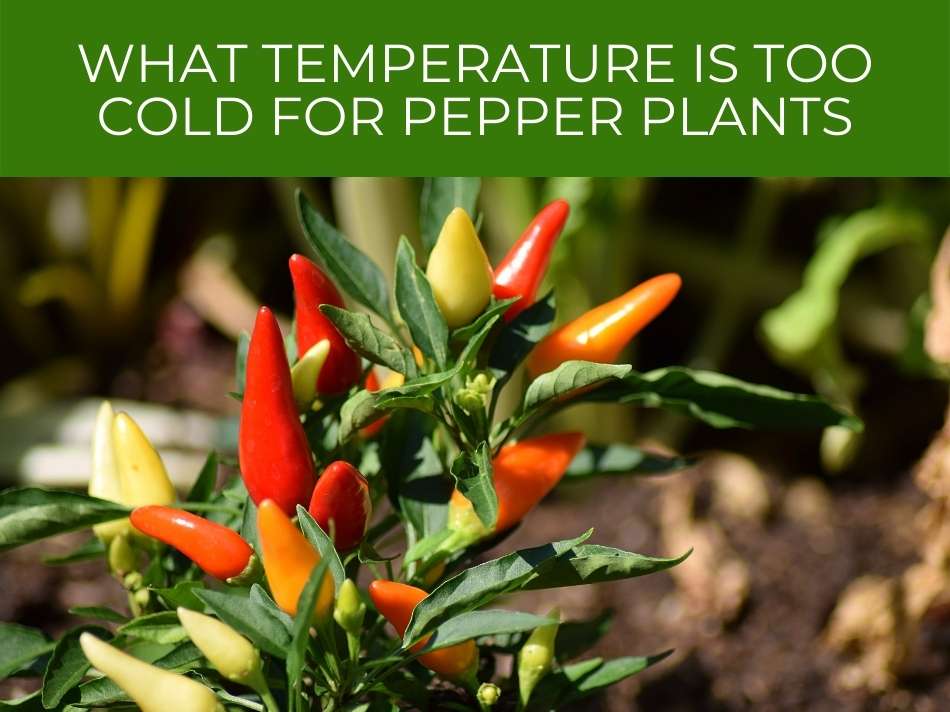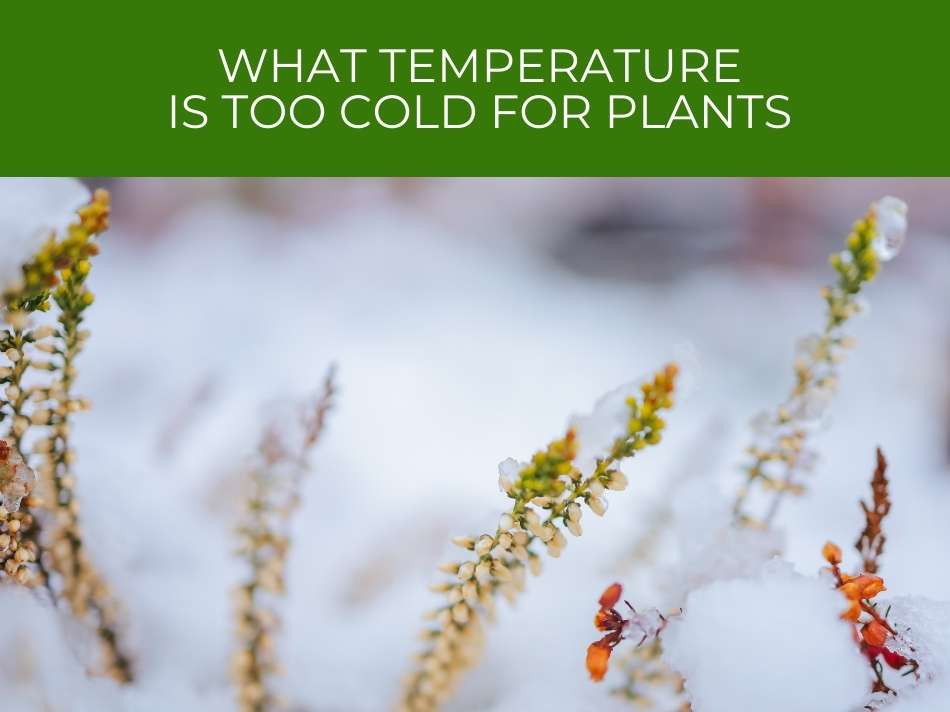Plants require specific key aspects to grow optimally, such as sufficient sunlight, good soil conditions, enough water, and a good climate.Some plants are able to handle colder conditions better than other plants, even thriving in these conditions.
Plants will develop frost when the temperature drops to 32°F. Most plants and seedlings will wilt and die from extreme cold. The cold temperature tolerance of the plant will differ from one plant to the next but the rule of thumb is that most plants will start to show damage from 50°F and below.
It’s important to understand the type of plant and which conditions it grows best in and which temperature will kill the plant.
See if 40 degrees is too cold for tomatoes.

What temperature is too cold for plants
Cold temperatures may be detrimental to growing plants.
Many gardeners and growers across the US wonder which temperatures are too cold for plants. This question has several answers as different categories of plants are able to handle different temperatures.
As a rule of thumb, most plants cannot survive in temperatures below 32°F.

Different types of plants can tolerate differing levels of cold. Most houseplants (many of which are tropical) can’t tolerate temperatures below 60°F; most ferns won’t tolerate temperatures below 50°F; vegetable plants & succulents can’t tolerate temperatures below 40°F.
The United States Department of Agriculture offers a map that highlights plant hardiness zones.
These zones indicate which plants will thrive in which locations. The map, divided into 10°F zones, is used by gardeners / growers and highlights the average winter temperature across zones.
These temperatures give gardeners insight into which plants will thrive in their location.
See 4 cold-hardy banana tree varieties.

How cold can seedlings tolerate
Some seedlings require winter cold in order to geminate such as temperatures as low as 50°F.
According to UConn College of Agriculture and Resources most vegetable and flower seedlings prefer a germination temperature ranging between 65°F to 75°F.
Most seedlings cannot tolerate temperatures below 32°F to 33°F. Tropical plant seedlings have different low-temperature thresholds that range between 35°F and 40°F. A few plants have seedlings that are able to tolerate temperatures as low as 18°F to 20°F.
There is a general rule of thumb that applies to all plants and seedlings alike: if the temperature drops to 28°F and remains at that temperature for more than five hours, plants will freeze and die.
Keep in mind that soil is able to hold heat longer, even if the temperature drops.
There are various ways to protect seedlings from weather that gets too cold.
See 3 cold-hardy fig tree varieties.

Is 50 degrees too cold for seedlings?
According to Iowa State University, most seedlings require a soil temperature of around 68°F to 86°F in order to germinate. A necessary process for the seedling to shed its protective skin and start growing.
The ideal soil temperature for growth should be approximately 10°F cooler than the soil germination temperature.
However, some seedlings require colder soil temperatures in order to germinate.

Hardy seedlings, like lettuce, tolerate colder conditions better than seedlings that grow in warmer climates. Also, these seedlings often tend to survive the frost as well. While 50°F may be too cold for seedlings that thrive in warmer conditions, it may be the ideal soil temperature for hardy seedlings.
Oregon State University states that hardy seedlings such as spinach, sweet onion, garlic, leeks, broccoli, kale, cabbage, etc. are able to tolerate temperatures below 28°F.
Semi-hardy seedlings can tolerate temperatures ranging between 28°F to 32°F. The lowest temperature that a seedling may be able to survive will depend on the type of seedling and whether or not they are hardy, semi-hardy, or not hardy at all.
Some, but not all, seedlings may survive below 50°F.
See how cold basil can tolerate.

How does cold temperature affect plant growth
Water has a major effect on growing plants. It can freeze inside the cell of the plant which may cause the plant to expand and thereby destroy the plant from the inside. The plant will start to wilt and die, even if the temperature has changed outside.
In addition, the water may freeze the exterior of the plant and the soil in which the plant is buried. This results in a process known as desiccation, which may, in turn, interfere with the water supply of the plant.
Cold temperature can disrupt the plants’ enzyme secretion activity which may cause a disruption in plant nutrient intake. This in turn, will result in the growth of the plant being stunted or the plant dying all together.
Damage as a result of cold weather is usually worse in younger plants that have not yet matured or developed the strength or structure to help the plant withstand the damage caused by the expanding cell tissue.
The colder weather may essentially damage the way that water and nutrients flow inside the plant which may adversely affect the health of the plant.
See how cold lettuce can tolerate.

How to protect plants from frost
Gardeners and growers should understand how the weather and zone will affect a specific type of plant.
This will help the grower understand when and how to take precaution against colder weather conditions such as frost.
To protect plants from frost, transfer them to pots and place them in an area that’s warm & frost free. In areas with less severe frost freeze, leave the plants/seedlings in the ground & cover the surface with 2-3” of loose mulch.
Alternatively, plants may be covered to help protect the plant from frost.
Always research the growing conditions and hardiness of the plant/seedling when and if in doubt.
See why tomato plants turn yellow (and how to fix it).

What temperature is too cold for potted plants
Potted plants should be moved indoors when the temperature inside and outside are more or less the same. If plants are moved when there is too much of a temperature difference, the plant may experience shock.
Generally, 45°F is too cold for most potted plants. Tropical and semi-tropical plants may need to be moved before the outside temperature reaches 50°F, whereas cold-hardy plants like lettuce & spinach can tolerate 28°F.
Indoor plants may be left outside when the outdoor temperature remains at 55°F or above. It’s important to keep an eye on the outside temperature when it comes to potted plants.
The general rule of thumb when placing potted plants outside is that the plant will freeze at temperatures below 28°F.
Find out why plants need water.

What temperature is too cold for tomato plants
Tomatoes originate out of subtropical conditions and have very specific growing conditions.
These plants need full sunlight, warm weather conditions, and nighttime temperatures that range between 58°F to 68°F.
Tomato plants are able to withstand temperatures of 33°F for brief periods (such as a few hours). However, tomato plants will experience stunting & wilting when the temperature starts to drop below 40-45°F.
Colder temperatures at night may interfere with these plants’ ability to photosynthesize.
In addition to this, the cooler temperatures may interfere with pollen production which may result in fewer fruits or deformed fruits.
Find out if plants can grow without water.

What temperature is too cold for pepper plants
There are a variety of pepper plants that each react differently to the colder weather conditions.
Other factors which may affect your plant’s tolerance to colder conditions may include the type of pepper plant, the location where the plant is growing, as well as the plant schedule.
Pepper plants will experience wilting & stunted growth below 40°F, & will die below 32°F. The ideal temperature range for most pepper varieties is 60°F to 90°F. Pepper plants can be protected from damaging low temperatures by covering them, & by surrounding plants with 2-3” of mulch.
Temperatures below 55°F will slow down the growth of mature pepper plants and temperatures at 32°F will cause frost and ultimately kill the plant.
Pepper plants should ideally be brought indoors before the first winter frost.

